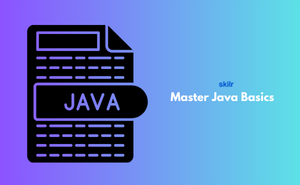👇 CELEBRATE CLOUD SECURITY DAY 👇
00
HOURS
00
MINUTES
00
SECONDS

Java Basics introduces learners to the essentials of programming with Java, a language used everywhere from small apps to large-scale business solutions. It covers the core building blocks like data types, operators, methods, and object-oriented concepts, all explained in a beginner-friendly way.
By mastering these basics, learners can confidently begin their journey into the world of software engineering. Java skills open doors to careers in web, mobile, and enterprise development, making it one of the best starting points in programming.
This exam is ideal for:
Domain 1 - Introduction to Java
Domain 2 - Java Basics
Domain 3 - Control Flow Statements
Domain 4 - Methods in Java
Domain 5 - Arrays and Strings
Domain 6 - Object-Oriented Programming Basics
Domain 7 - Exception Handling
Domain 8 - Introduction to Collections
Industry-endorsed certificates to strengthen your career profile.
Start learning immediately with digital materials, no delays.
Practice until you’re fully confident, at no additional charge.
Study anytime, anywhere, on laptop, tablet, or smartphone.
Courses and practice exams developed by qualified professionals.
Support available round the clock whenever you need help.
Easy-to-follow content with practice exams and assessments.
Join a global community of professionals advancing their skills.
Yes, Java is used in backend web development with frameworks like Spring.
Learning Java first gives you strong programming fundamentals that make switching easier.
Absolutely, it remains one of the most in-demand programming languages.
Yes, Java basics build a strong foundation for problem-solving in coding challenges.
Yes, basic debugging and error-handling techniques are included.
Banking, IT services, e-commerce, healthcare, mobile apps, and more.
Yes, it prepares you for entry-level Java development roles.
Yes, it introduces classes, objects, and inheritance.
Yes, Java is the foundation of many Android apps.
Java is beginner-friendly, widely used, and builds a strong base for other languages.
Variables, loops, methods, OOP basics, and simple data handling.
No, this starts with fundamentals and assumes no prior programming background.
Beginners, students, or anyone new to programming.
It provides a basic intro but deeper database work comes in advanced Java.
You can grow from junior developer to full-stack developer, mobile app engineer, or enterprise-level software engineer.